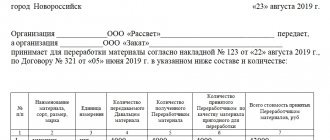The enterprise's own funds, without which it cannot carry out economic activities, are primarily represented by various types of capital: authorized, reserve, additional. This also includes retained earnings. Additional capital – creating “insurance” for the enterprise in case of an unfavorable economic situation. A legal entity can spend accumulated funds only in areas specified by law.
Question: Can a foreign organization - a participant in an LLC (100%) that does not have a representative office in the Russian Federation, transfer the amount of the loan debt and interest into the authorized or additional capital of the company? What are the income tax consequences in this case? View answer
Is additional capital an asset or a liability?
From an economic point of view, additional capital is a certain monetary value formed in the company, which does not entail any obligations of the company to its counterparties.
In this regard, additional capital directly affects the company’s net assets, and therefore its overall welfare, and the value of such a business. For information on how the current value of a company’s net assets is assessed, see the articles:
- “Net assets - balance sheet calculation formula”;
- “The procedure for calculating net assets on the balance sheet - formula.”
As a general rule, an organization is considered to be more stable financially, the greater the value of its own funds relative to borrowed funds. Additional capital refers specifically to the company's own funds. Therefore, in accounting, its value is reflected as part of the company’s equity capital (clause 66 of the Regulations on accounting, approved by order of the Ministry of Finance of the Russian Federation dated July 29, 1998 No. 34n [hereinafter referred to as Regulation No. 34n]).
What is equity and how to calculate it, read the article “Equity on the balance sheet is...”.
As a general rule, an organization's equity accounts are passive accounts. Additional capital is no exception: accounting is kept on account 83. Accordingly, an increase in its value is accompanied by entries to the credit of account 83, and a decrease - by entries to the debit of account 83.
Check whether you are accounting for additional capital correctly with the help of advice from ConsultantPlus. If you do not have access to the K+ system, get a trial online access for free.
In the financial statements, additional capital is also reflected in the liability side of the balance sheet (in section III).
What is a balance sheet and how to fill it out, read the articles:
- “Balance sheet (assets and liabilities, sections, types)”;
- “The procedure for drawing up a balance sheet (example).”
Optimal average value
Equity is important because it represents the true value of a share in the share capital. Investors who own shares in a company are usually interested in their own personal equity in the company represented by their shares.
However, such personal capital is a function of the total capital of the company itself, so a shareholder interested in his own earnings will necessarily have an interest in the company.
Owning shares in a company provides capital gains for the shareholder and potential dividends over time. It also often gives the shareholder voting rights at the founders' meeting. All these benefits further increase shareholder interest in the company.
Most often, the average value for the year is used to assess equity capital, which allows you to most accurately determine its variations over time.
The formula for calculation is as follows:
Sk = (Sk at the beginning of the year + Sk at the end of the year) / 2
The data is taken from the balance sheet for the relevant reporting periods.
Shareholders have voting rights and other privileges that come only with ownership, since capital represents a claim to a proportionate share of the company's assets and earnings. These claims are generally those of creditors, but only shareholders can truly participate in and benefit from the growth in the value of the enterprise.
Some financial instruments have the characteristics of equity, but are not actually equity. For example, convertible debt instruments are loans that convert into equity when the company (the borrower) crosses certain thresholds, thereby turning the lender into an owner in certain cases.
Stock options also act like shares in that their value changes with the value of the underlying shares, but option holders generally do not have voting rights and cannot receive dividends or other financial instruments.
It's important to understand that while equity represents a company's net worth, a company's stock is ultimately only worth what buyers are willing to pay for it.
It is highly desirable that the amount of equity capital or net assets be higher than the amount of the company's authorized capital. This criterion is important from the point of view of maintaining the investment attractiveness of the business.
A business must pay for itself and ensure an influx of new capital. Sufficient equity capital is one of the most significant indicators of the quality of a company’s business model.
What is own working capital? Details are in this article.
How much is additional capital generated?
Clause 68 of Regulation No. 34n states that the enterprise generates additional capital through:
- carrying out additional valuation of non-current assets in accordance with the law;
- receiving a sum of money exceeding the nominal value of the issued shares (share premium of the joint-stock company);
- receipts to the company of other amounts of a similar nature.
NOTE! Additional capital includes all these funds, however, in the accounting (balance sheet) each of the listed amounts that form the DC must be reflected separately.
Let's consider each of these methods in more detail.
Firstly, an organization’s additional capital can be formed (increased) by revaluing (namely revaluing) the company’s non-current assets (i.e. fixed assets). Revaluation consists in the fact that not only the initial (current) cost of an asset is subject to recalculation, but also the amount of depreciation accrued in the aggregate for previous periods for the asset (clause 15 of PBU 6/01 “Accounting for Assets”, approved by order of the Ministry of Finance of the Russian Federation dated 03/30/2001 No. 26n).
From 2022, PBU 6/01 will no longer be in force. Instead, you will need to apply FSB 6/2020 “Fixed assets” and 26/2020 “Capital investments”. You can start applying standards earlier by fixing the decision in your accounting policies.
ConsultantPlus experts explained in detail how the procedure for accounting for fixed assets and capital investments will change. Get free demo access to K+ and go to the Review Material to find out all the details of this procedure.
IMPORTANT! The company has the right to revaluate fixed assets no more than once a year. Moreover, if a company decides to revaluate its fixed assets, then it must be borne in mind that in the future the revaluation will have to be carried out regularly (requirement of clause 15 of PBU 6/01).
If, as a result, the recalculated value of the fixed assets exceeds the previous one, formed based on the results of the previous revaluation (if the revaluation is carried out for the first time, the original value is taken into account), then the value of the additional valuation forms additional capital.
If the company, based on the results of the previous revaluation, identified a decrease in the value of fixed assets (markdown) and wrote it off as expenses (this must be done due to the direct requirement of clause 15 of PBU 6/01), then if an increase in the value of fixed assets is identified in the subsequent period, the amount of the revaluation will not be included in additional capital, but will have to be accounted for as other income.
Additional capital without revaluation in the balance sheet - what is it and how is it formed
The second basis for the formation of the authorized capital is related to the receipt by the joint-stock company of income from the sale of shares in an amount greater than their nominal value.
NOTE! Formally, such a basis is prescribed by the legislator only for JSC. At the same time, regulatory authorities apply a similar rule to LLCs. Therefore, if an LLC sells a participation interest at a price exceeding its nominal value, the company also generates share premium, which forms additional capital (letter of the Ministry of Finance of the Russian Federation dated September 15, 2009 No. 03-03-06/1/582).
The third circumstance leading to the formation of additional capital of the company, provision No. 34n names the receipt by the company of other amounts of a similar nature.
Such amounts include, for example:
- receipts from the founders that do not change the size and nominal value of their share in the authorized capital (Article 27 of the Law “On Joint Stock Companies” dated 02/08/1998 No. 14-FZ, Article 32.2 of the Law dated 12/26/1995 No. 208-FZ, section “Reflection joint-stock company information on contributions to its property" in the appendix to the letter of the Ministry of Finance of Russia dated December 28, 2016 No. 07-04-09/78875);
- property received by a unitary enterprise from the owner for economic management in excess of the size of the authorized capital (see section “Disclosure by a federal state unitary enterprise of information about property received for economic management in excess of the size of the authorized capital” in the appendix to the letter of the Ministry of Finance of Russia dated January 22, 2016 No. 07- 04-09/2355).
If the founder is a foreigner and he decides to contribute funds to the business in the form of foreign currency, then a basis for the formation of additional capital may also arise here. After all, the moment of reflection in the accounting of the operation of depositing funds by the founder and the moment of their actual receipt at the company’s cash desk may fall on different dates (due to the accrual principle). As a consequence, if the ruble value of the contributed funds on the date of their actual receipt is greater than the ruble value at the time of formation of the founder’s debt to the company in accounting, then a positive exchange rate difference is formed. It must be included in the company’s additional capital (clause 14 of PBU 3/2006 “Accounting for assets and liabilities in foreign currency”, approved by order of the Ministry of Finance of Russia dated November 27, 2006 No. 154n).
If an organization operates outside the Russian Federation, then assets and liabilities in foreign currency arising in this activity must be recalculated into rubles when preparing financial statements. The differences arising as a result of the recalculation of these assets and liabilities are credited to additional capital (paragraph 2 of clause 19 of PBU 3/2006).
Additional capital also includes the amount of VAT recovered by the founder when transferring property as a contribution to the authorized capital and transferred to the established organization (subclause 1, clause 3, article 170 of the Tax Code of the Russian Federation, letter of the Ministry of Finance of Russia dated October 30, 2006 No. 07-05-06 /262, dated December 19, 2006 No. 07-05-06/302). In addition, some possibilities for the formation of DCs are provided for by the Chart of Accounts, approved by Order of the Ministry of Finance of the Russian Federation dated October 31, 2000 No. 94n.
In particular, the document states that with account 83, in addition to those indicated above, accounts 84 “Retained earnings” and 86 “Targeted financing” can correspond. Consequently, additional capital can be increased using some of the profit remaining after payment of dividends, as well as with the help of targeted income from investors.
Thus, there are very specific ways to form a DC in a company, which every manager should have a clear understanding of in order to strengthen the financial position of the company.
At the same time, since it is generally accepted that this type of capital is a kind of safety net for the organization, the question arises: in what situations does its presence benefit the company?
Section 3 of the balance sheet
Section 3 of the balance sheet is called “Capital and Reserves”. The name speaks for itself and suggests what data will be collected here. This is the passive side of the document, reflecting the organization’s own funds and borrowed funds.
These funds are generated from the following sources:
- Authorized capital;
- Additional funds;
- Reserve Fund;
- Profit remaining after distribution.
The financial result is formed as the difference between what the company owns and its debts. If a company has more liabilities than its cash fund, we can talk about losses. If there is more money than debts, then this is profit.
Read on topic: Balance sheet for the year
The section includes 6 lines and a seventh final line. Each of them, except the last one, is tied to a specific account. Therefore, filling out the form will not be difficult. You just need to correctly transfer the balance from your accounts.
| Line | Check |
| Authorized capital (share capital, authorized capital, contributions of partners) | Kt 80 |
| Own shares purchased from shareholders | Dt 81 (negative number is placed in parentheses) |
| Revaluation of non-current assets | Kt 83 (only the difference between revaluation and original cost) |
| Extra capital | Kt 83 everything else except revaluation of VA |
| Reserve capital | Kt 82 |
| Retained earnings (uncovered loss) | Possible options: Kt 84 and Kt 99; Dt 84 and Dt 99; Kt 84 minus Dt 99; Kt 99 minus Dt 84 |
If during the reporting period additional funds were contributed to the management company, but they are not reflected in the statutory documents, then a special column will have to be allocated for them. You can’t just add them to the Criminal Code. This remark also applies to interim dividends.
Account 83: features of reflecting additional capital
Additional capital is called a safety cushion primarily because it, as a rule, is not spent. This is indicated in the instructions for using the Chart of Accounts (account 83), where, in particular, it is explained that the amounts that were credited to account 83 are, as a general rule, not written off in the future. At the same time, it is indicated that entries in the debit of account 83 can be made, but only in certain situations:
- when repaying the identified writedown of non-current assets;
- in order to increase the authorized capital of the company;
- when distributing these amounts among the owners of the company.
The identified additional valuation of fixed assets increases additional capital. The opposite situation arises if fixed assets that were overvalued in previous periods show a decrease in their value based on the results of the current revaluation. Such a reduction (markdown) will reduce the company’s capital capital (clause 15 of PBU 6/01).
IMPORTANT! A decrease in additional capital will occur only if the amount of the identified depreciation does not exceed the amount of the total revaluation of fixed assets for all previous periods. If there is an excess, it will be attributed to the financial result and included in other company expenses.
In addition, paragraph 15 of PBU 6/01 states that if any fixed asset is disposed of in an organization, then additional capital must be reduced by the previously identified amount of its revaluation and this amount must be transferred from the capital assets to retained earnings (para. 7 clause 15 PBU 6/01).
NOTE! In order to be able to identify the amount of additional valuation for a specific fixed asset, it is important to keep records for each fixed asset in separate subaccounts in the context of account 83.
The second direction in which an organization can use additional capital is to increase its authorized capital. This method is equally applicable to both JSC and LLC. After all, both the Law “On JSC” dated December 26, 1995 No. 208-FZ, and the Law “On LLC” dated February 8, 1998 No. 14-FZ allow increasing the authorized capital at the expense of the company’s own funds.
IMPORTANT! However, there is one limitation here: you cannot increase the authorized capital using the company’s own funds by an amount greater than the value of its net assets minus the current amount of authorized and reserve capital (clause 2, article 18 of Law No. 14-FZ, clause 5, art. 28 of Law No. 208-FZ).
The third possible use of a company's DC is its distribution among owners.
Therefore, the company’s management, if desired, has the right to decide to pay certain funds from the additional capital to the participants (shareholders) of the company.
In addition, there is a situation when a company is obliged to distribute DCs among its owners. This is what you should do when liquidating a company. In order to identify the total amount of funds to be distributed among the owners upon liquidation, it is necessary to write off the balances of all funds and reserves of the company, which include additional capital, to account 75.
The procedure for accounting for additional capital can be found in the articles:
- “Keeping records of additional capital on account 83 (postings)”;
- “The procedure for accounting for an organization’s own capital (nuances).”
Line by line filling out section 3 of the balance sheet
When completing the third section of the balance sheet, please note that the form itself does not indicate line codes. However, they must be reflected when submitting a report to the Federal Tax Service and Rosstat. The necessary figures are contained in Appendix 4 of Order of the Ministry of Finance No. 66 dated July 2, 2010. (as amended on 04/06/2015)
Indicators are entered according to three dates. For example, for the 2019 balance sheet, this is the reporting date, 12/31/2018 and 12/21/2017.
| Column name | Code | What amounts to include |
| Authorized capital | These are funds contributed by the organizers of the company when it was created. The collected amount must certainly be recorded in the constituent documents. You can't just change numbers. Any increase or decrease in capital goes through registration with the Federal Tax Service. Important! If a certain amount of the Criminal Code exists only on paper. That is, the founder has not yet listed it. Or someone owes money to the management company. All this is written in other lines. 1310 and the data of the constituent document must match. | |
| Own shares purchased from shareholders | If the company is one of the types of joint-stock companies, then in this column enter the price of shares purchased from their holders. After purchase, they will be sold again or reset to zero. (The number is placed in parentheses.) | |
| Revaluation of non-current assets | If during the reporting period you revalued fixed assets or non-current assets that increased in value, this result will have to be entered into the balance sheet. It is the growth that is shown. | |
| Additional capital (without revaluation) | This is a financial increase for the company (not to be confused with profit), but this cannot include the revaluation of fixed assets and VA. What data is reflected in the column:
| |
| Reserve capital | This part is intended more for JSC. Since they have an obligation to create a reserve fund (minimum 5% of profits annually). LLCs do this at their own discretion. Transfer the figure from the balance according to Kt82 here. This money can be spent to compensate for losses, to purchase shares (if there is no other way out), or to pay off bonds. | |
| Retained earnings (uncovered loss) | The monetary result of the company's work during the reporting period. If it is positive, it is a profit, if negative, it is a loss. A zero indicator is extremely rare. Be careful! Negative data is given in parentheses. There is no minus before the number. |
Since the column “Retained earnings (uncovered loss)” is the most important. It makes sense to dwell on its filling. This is what we did next.
Use of additional capital: controversial issues
In addition to the generally established cases of using additional capital, which in practice do not cause much controversy, there are also several controversial situations.
In practice, many companies experience losses at least once over several years. At the same time, among specialists of those companies in which the DC has been formed, differences of opinion very often arise on the following question: is it possible to cover the losses incurred in previous years at the expense of the DC?
On the one hand, it can be assumed that since the current legislation does not directly provide for such an area of spending additional capital, it cannot be used to cover losses.
On the other hand, the current civil, accounting and tax legislation does not contain a direct prohibition to do this. The regulatory authorities only noted that it was impossible to cover losses at the expense of that part of the capital account that corresponds to the amount of additional valuation of fixed assets (letter of the Ministry of Finance of the Russian Federation dated July 21, 2000 No. 04-02-05/2).
Disputes arise in practice and around another situation. As mentioned above, with the help of DCs you can partially increase the authorized capital. However, the additional capital itself consists of funds of different economic nature. The question arises: can any parts of the cultural center increase the charter? After all, the DC may include, for example, amounts of positive revaluation of fixed assets, which do not actually form a real cash flow in the company.
On the one hand, PBU 6/01 allows the amount of the identified revaluation to be used either to cover a subsequently identified writedown of fixed assets, or to increase the firm’s retained earnings (if the fixed assets are disposed of). Whether it is possible to contribute additional capital in this part to increase the authorized capital is not indicated in the PBU.
At the same time, the legislator does not limit the right of the organization to use additional capital to increase the authorized capital, depending on the exact nature of the individual parts of the DC. In addition, the regulatory authorities also do not provide any exceptions to the rule allowing an increase in the company’s authorized capital at the expense of additional capital (letter of the Federal Tax Service of Russia for Moscow dated April 1, 2005 No. 20-12/21866).
Therefore, it seems that the organization has the right to independently decide which parts of the DC should be aimed at increasing the charter.
Features of working with column 1370 of Section 3 of the balance sheet
Column 1370 is issued by all enterprises without exception. It does not matter that by the time of the report the expected profit has not been received. In this case, enter a negative value, but without the minus sign. Simply enclose the desired amount in parentheses. For example: (25,000).
1370 is data for account 84, if you draw up a balance sheet as of December 31 of the reporting year. To get the full picture, first close accounts such as 90, 91, 99.
- If the result is positive, the balance will hang according to Kt84;
- If the result is negative, the remainder is taken according to Dt84.
Depending on whether Dt or Kt of account 84 is included in your balance, the final column under code 1300 will either increase or decrease. But here everything is clear: we add the profit to the total, and subtract the loss.
If you need to submit interim results to the Federal Tax Service, account 99 “Profits and losses” is also involved in the preparation of this line. This is where you report your financial results throughout the year.
Results
In some cases, the company’s additional capital serves as good insurance, a tool for financial support and increasing the stability of the company. Therefore, it is important to remember that a DC can be formed through the revaluation of fixed assets, the sale of a share in the company at a price higher than the nominal price, as well as as a result of the receipt of other amounts that are similar in their economic essence. At the same time, additional capital cannot be used for any purpose. At the expense of the DC, the legislator allows to repay the identified depreciation of fixed assets, increase the authorized capital of the company, and distribute the DC between the owners. Other cases of using such funds are also possible, but they are not transparent and clearly legal. In accounting, additional capital is a liability of the organization, accounted for in account 83. At the same time, in the context of account 83, the company should keep analytical records of the amounts of individual parts of the capital account, formed on independent grounds.
Sources:
- Tax Code of the Russian Federation
- accounting regulations, approved. by order of the Ministry of Finance of the Russian Federation dated July 29, 1998 No. 34n
You can find more complete information on the topic in ConsultantPlus. Free trial access to the system for 2 days.






